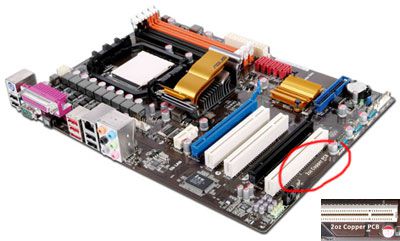From our front-page news:
When Gigabyte first introduced their "2oz copper" motherboard feature last year, many scoffed at their claims of better overclocking, improved power efficiency and lower board temps. ASUS was included in this mockery, and in some cases, I was with them. I failed to understand how twice the copper would improve things, but even to this day, I don't know if there's direct proof of improvements, so it's hard to conclude on anything.
With Gigabyte's recent focus on extreme overclocking, it could be that the 2oz of copper does indeed make a difference, and with a new find made by the folks at BSN*, it looks like there may be some substance to this substance after all. How so? Well, it appears that ASRock, the budget split-off of ASUSTeK, had a motherboard on display at Computex that featured text at the bottom which stated, "2oz Copper PCB". Hah!
This move is a little bizarre given ASUS' hardcore stance against the overuse of copper. So either the company stumbled on a fresh supply of the stuff, or there may really be value in adding twice as much to our motherboards. But, it could also simply be a way to draw some eyes away from the competition. Let's just hope ASRock doesn't have a 32 phase-power board on the horizon...

However, most surprising news is that ASUS seems to be joining its adversaries, so to speak, with its M4A77TD PRO board, introduced last week, during Computex Taipei 2009. The board, which is based on the AMD 770 and SB710 chipset combo, offers support for DDR3 memory and ATI’s CrossFireX technology. These things aside, the board really brings little new to the table. Oh, perhaps we forgot to mention the white letters present at the bottom of the PCB?
Source: Bright Side of News
With Gigabyte's recent focus on extreme overclocking, it could be that the 2oz of copper does indeed make a difference, and with a new find made by the folks at BSN*, it looks like there may be some substance to this substance after all. How so? Well, it appears that ASRock, the budget split-off of ASUSTeK, had a motherboard on display at Computex that featured text at the bottom which stated, "2oz Copper PCB". Hah!
This move is a little bizarre given ASUS' hardcore stance against the overuse of copper. So either the company stumbled on a fresh supply of the stuff, or there may really be value in adding twice as much to our motherboards. But, it could also simply be a way to draw some eyes away from the competition. Let's just hope ASRock doesn't have a 32 phase-power board on the horizon...

However, most surprising news is that ASUS seems to be joining its adversaries, so to speak, with its M4A77TD PRO board, introduced last week, during Computex Taipei 2009. The board, which is based on the AMD 770 and SB710 chipset combo, offers support for DDR3 memory and ATI’s CrossFireX technology. These things aside, the board really brings little new to the table. Oh, perhaps we forgot to mention the white letters present at the bottom of the PCB?
Source: Bright Side of News
